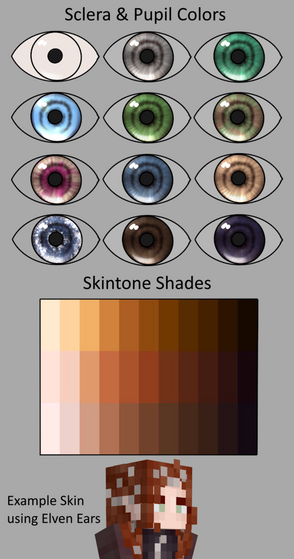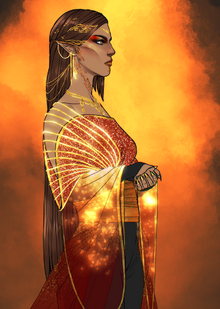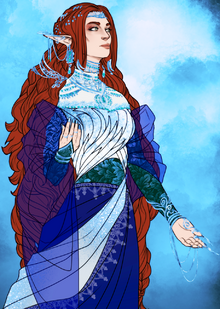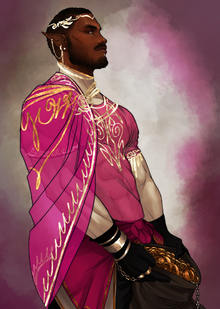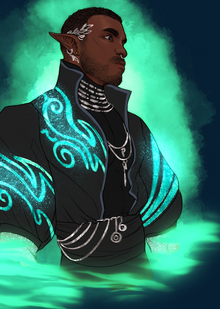Lanlath
| Lanlath | |
|---|---|
|
| |
 | |
|
| |
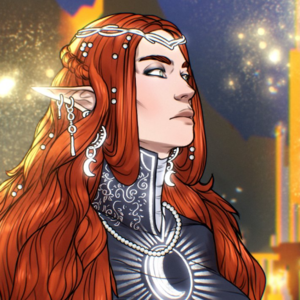 | |
| Nation State | Lathan Empire |
| Ruler | Varied Princes and Princesses |
| Other Present | None |
| Languages | Altalar |
| Religion | Estelley |
| First Recorded | 15,000 BC |
| Demonym(s) | Lanlath |
The Lanlath are the classical High Elves of Aloria, skilled in Magics, clever and thoughtful with their words, and with poise and grace that is difficult to rival by the other Races of the world. The Lanlath are the Elves of the hidden valleys, a nation without boundaries that was once expelled from the ancient Allorn Empire for resisting conformity with the ever-expanding and brutalizing Elven dominion. Under the guidance of their secular and religious leaders, the Lanlath departed from the Allorn Empire, creating a realm of their own where the sentiments of justice, compassion and grace would temper the chaos and powerful allure of Magic. The Lanlath are best known across the world for their secretive Empire in the in-between lands, and their contributions to the creation of Radiant Magic, inventing for the first time in Alorian history the means to use Magic without damaging the world and the people in it. The Lanlath have two unique pupil colors (seen right), the Lanlath Midnight and Lanlath Sunrise. The Midnight variant is a dark-gray blue with glowing white specks that imitate the night sky, while Sunrise is ivory colored on the outside, and magenta colored on the inside with inner-heterochromia (two colors in each pupil).
Design
The Lanlath are Aloria's interpretation of the High Elf who is above it all, too detached from the world to care about the chaos in it, too enlightened to engage in the banal discussions that invoke family drama and romance conflict. The Lanlath come in two flavors: resting-bitch-face, and sees-right-through-you-face, where even if a Lanlath is kind-natured and has good intentions to others, much of that goodwill is undercut by how bored or "done" they look with the world. The Lanlath always invoke a floating and drifting mind, expressed with elegant and fluid poise and class, and an abhorrence of chaos, unruliness, and wildness. Lanlath don't all need to be thin spindly or frail-looking, just like the other Elves Lanlath are surely capable of packing on muscle and weight, though due to their high rates of vegetarianism and sometimes just forgetting to eat while musing their theories or playing the harp, these are more the exception than the norm. The Lanlath have a wide variety of visual traits, as seen in the sheet to the right. Most Lanlath veer on the tall side and frequently keep their hair long and well-maintained. Finally, Lanlath expressions of emotion and passion are extremely muted, or well hidden away from the public. Many Lanlath would consider holding hands very risqué, and think a hug is some form of intimate contact.
Lanlath in Regalia
Lanlath are certainly some the least numerous Elves in Regalia (bar for perhaps the Sihndar), due to the habit of the Lanlath to remain in Lathan, their homeland and Empire in the in-between lands. There is however a healthy exchange of people going between Lanath and Regalia, for a variety of reasons, that can all be used to explain why a Lanlath Character might be in Regalia:
- Lanlath are naturally akin to therapists, diplomats, or problem solvers, who use their own ascended philosophies, to help guide others to peace and healing.
- Lanlath despite being detached from the world of Aloria, are sometimes still concerned about the Chaos in it, and will help the other People of Aloria keep it safe.
- Lanlath are natural musicians, poets, and lovers of art and beauty. Many of them travel to Regalia to learn from other musicians, or to share their art with the world.
- Some Lanlath are Knights, being members of the Senleya Order and helping the Regalian Empire preserve peace and stability and giving final mercy to Spirits.
- The Lanlath are often a cornerstone to "proper" Magic teaching by straying from Sinistral, and following their Radiant theories. They often teach Magic in Regalia.
- Lanlath are often speakers for causes for the good of the world that the general public ignores, like the Sihndar struggle, the Dwarven extinction, the Isldar war etc.
Heritage Traits
When designing a Character, Proficiency Points allow for a limited Ability selection with Point Buy Packs. Heritage Traits adds free Packs and Mechanics on top of that to help with cultural themes. Free Packs grant Abilities usually, while Mechanics change the way a character functions in Roleplay through subtle, and usually out of Combat ways. In essence, Mechanics just add aesthetic flair that invest in the niche of each culture. Free Packs never raise Proficiency Points, but the character must be able to purchase them normally. (ex. if a character is a certain Affinity that locks them out of a category, they cannot take that specific free pack and must choose the alternative option.) If a Free Pack grants Magic of some type, that Magic can be of any Alignment the character can normally choose, or limited to a select alignment, which will always be written in the Free Pack description. Mixed Heritage characters (i.e. characters born from two parents of different Cultures) may take one parent's 'Free Packs' and mix and match up to 5 Mechanics from both parents, although some Peoples cannot produce Mixed Heritage children (due to Magical/Fantasy reasons).
Free Packs
- Lanlath choose two Packs from Magic Point Buy for free.
Mechanics
- The two Free Magic Packs chosen from Heritage Traits, can be used as the Sinistral Variant, but will always be Radiant instead and cannot be forced Sinistral.
- Lanlath cannot use God Magic. However, Lanlath can Dimension Align to Lathan Magic, which is extradimensional like Void/Exist/Ordial, and unique to the Lanlath.
- Lanlath do not need to sleep, but can do so if they wish, or enter into a trancelike state of meditation that approximates sleep but leaves them watchful.
- Lanlath can see things from incredibly far away if they focus, able to spot an eagle landing a kilometer away or a coin being flipped across a town. Ask DM for Event use.
- Lanlath are supremely difficult to inebriate with traditional alcohol, requiring a stupendous amount of liquor before they even begin to feel a mild buzz.
Lathan Essence
Lathan Essence is magical energy from the Lathan dimension, explained further below. Lathan is both a Dimension and a Dimensional Alignment, much like the Void, Exist, or Ordial Dimensions are, but it is distinctly different from them. Unlike these Dimensional Essences, Lathan Essence is completely incapable of corrupting Aloria by itself. Lathan Essence can still be used to generate Sinistral Magic, and it can still cause widespread destruction, but the passive existence of it does not twist and corrupt plant life like for example Ordial or Void Essence would. Lathan Essence is identified as sereneness, light-headedness, foggy-ness, feelings of floating, and feelings of weightlessness. It is generally ascribed good qualities, but this again does not mean it is exclusively good and other forms of transdimensional Essences purely bad. Lathan Essence has in part affected the Lanlath to a degree of detaching them from worry and involvement or a sense of responsibility over Aloria. This is also why some of its critics, call it the "Apathy Magic". Lathan Essence is technically a fifth Dimensional Alignment, but is not present on the Magic Page because it is only accessible to Lanlath.
Starbirth
Lanlath have a cultural tradition that each Lanlath goes through as they come of age, known as the Starbirth. Lanlath distinguish a difference between natural birth and Starbirth, in that the latter occurs during a coming of age ceremony in a Star Chamber, where the ambient magics reveal their personality and inclinations, then forming a Star in the ceiling of the room to indicate between the four Starsigns. The Lanlath acknowledge that some Dimensions are more suitable for certain personalities, while other personalities cause calamity if they come into contact with certain Dimensions. In a way, Starbirth is how the Lanlath find the most appropriate Dimensional Alignment for their people, so that they can best master the arts, and have as little risk as possible to be corrupted or possessed by a Spirit. Starbirth does not prevent a Lanlath from Aligning with multiple Dimensions in the future, but this considered a massive Taboo in Lanlath society, to defy the will of the Star Chamber, and reason enough to become pariah to Lanlath society, those individuals referred to as Starfallen. It is not possible to be Starborn to God Magic, as the Lanlath are unable to use God Magic due to their connection with the Dimension Lathan. Note that the color distinctions of Void Gold-Red, Exist Blue-Silver, Ordial Black-Green, and Lathan Magenta-Ivory are purely aesthetic visuals. Nobody is forced to clothe themselves in colors they do not like, though it is always a fun little alignment indicator for people's styling.
|
|
|
|
Lathan
To fully understand the Lanlath, Lathan must be known both as a cultural concept and what it is. Lathan, much like the Void, Exist, or Ordial, is a distinct Dimension separate from Aloria, however it is not quite the same as these very alien realities. How Lathan was originally found or created is unclear. There are prevailing theories that Lathan was created by the first Lanlath exiles from the Allorn Empire, while others claim that Lathan is the mind of a God, while others yet claim that Lathan was already in existence, but that it was devoid of life, and that the Lanlath cultivated it when the Estelley God Leyon opened the doors. Whatever the origins, Lathan is the Lanlath homeworld away from Aloria. They tried to create a land of their own, but would not conquer or take land from other cultures or people, and so manifested an Empire in the "in-between lands" as it is sometimes called. There are several entry points into Lathan, large gateways on the major continents that are guarded by the Lanlath on both sides, but the majority of them are concentrated in the island chain located to the west of Regalia, on Maartasil, Etosil, and Mirtasil, which was once the easternmost border of the Allorn Empire. Lathan is a magical realm where time does not seem to pass. The sky is permanently cast in a cloudless dark blue haze, while the sun shines a bright golden magenta glow over everything. The valleys are outlined with massive mountains going nowhere, rolling pine forests with no creatures save for the Lathan dove, and rivers without fish irrigating farms from which the Lanlath eat. Their cities are vast citadels of ivorystone, with golden domed roofs that reflect the permanently setting sunlight. Lathan appears as if it is in a permanent autumn sunset, fogs rolling along the periphery of the cities which are often hundreds of miles apart from one another with endless stretching abandoned wilderness in between, with only elemental gateways connecting them and allowing fast travel between them. Lathan is a peaceful realm, where the Gods of Aloria and other Dimensions cannot tread, and where those who have ill will towards the Lanlath are magically rebuked from entering the gateways to this tranquil place. The Lanlath protect Lathan with their lives, and are equally as fanatic in preserving its secrets. Only the most trusted non-Lanlath could ever dream of entering Lathan, to live with a loved one, or study under an Archmage of the Lanlath.
Language and Naming
Lanlath language has remarkably remained consistent with early Allorn Altalar, and continued to develop along with the language spoken by the other Elves insofar it never developed a dialect. The Lanlath were keenly interested in remaining linguistically fluent with their Elven cousins from Aloria, and so took effort to record linguistic changes over the millennia to adopt themselves in Lathan. As a result, the Lanlath speak modern Altalar, and can speak this fluently with anyone who also speaks Allorn-taught or otherwise-taught Altalar. Altalar as a language is a fantasy language that borrows some verbage from modern day Spanish, but cannot be taken one to one. Altalar is meant to change much of the vocabulary by softening hard consonants, stressing vowels, and generally smoothing out the pronunciation. A good example might be the words "Adios, Gracias, and Hola" Altalar does not contain the consonants D, R, or H from these examples. To make these words sound more in-lore Altalar, Adios would become Alïos, Gracias would become Ce'lias, and Hola would become Äula. It is not recommended to try and translate whole sentences from Spanish, this is purely for the flair of some word usage in day-to-day roleplay. Lanlath naming principles follow the same rough rules, translating well from modern Spanish names in the examples listed below.
- Example Male Lanlath Names: Ëasiel (Daniel), Lüsas (Lucas), Näul (Raul), Noveyn (Robert), Äuonshe (Jorge), Lavlo (Pablo), Mancel (Marcus), Sönsalo (Gonzalo), Na'ael (Rafael), A'losso (Alfonso).
- Example Female Lanlath Names: Samila (Camilla), Isaveyl (Isabel), Sa'alia (Natalia), Siliana (Clara), Fisonia (Victoria), Savniella (Gabriella), Veani (Beatrix), Nassissa (Fransisca), Eyfa (Eva).
- Example Unisex Lanlath Names: Sil (Gil), Aleycis (Alex), Ëasi (Dani), Eysmeynlea (Esmeralda), Äuiamey (Jaime), Monshaa (Morgan), Qüiem (Quim), Feyno (Vero), Savia (Gabi), Cimme (Kim).
Furthermore, Elven naming can be complex if they use their full formal name. Their name starts with the first name, for example Noveyn, followed by a middle name Na'ael (for example being named after one's grandfather Na'ael), and finally a surname. This is then added to by the place where this Noveyn Na'ael Selven came from, being the Lathan City of Vashaäel by adding Bel- in front of it (so Bel-Vashaäel). Finally, Lanlath distinguish their current family loyalty at the end of their name as Elasis (Regalia), Alloneï (Allorn), or Lathai (Lanlath) So if this family was Regalia loyal, it would be in full: Noveyn Na'ael Selven Bel-Vashaäel Elasis, or just Noveyn Selven in short. If you need help with Elven naming, please make a Ticket on the Roleplay Discord so our more experienced linguists can help you.
Brief History
Lanlath History begins at the onset of the Allorn Empire's foundation. While the Allorn Empire was an ethnostate, to assume that every Elf always thought the same as the Empire's rulers, was a folly and the Allorn Empresses have been keenly aware of this all across history. Before the Lanlath existed as a distinct culture, their forerunners were considered conscientious objectors to several practices engaged in by the Allorn Empire. The first major objection these objectors had, was the usage of Magic to subjugate what they thought of at the time as the lesser peoples. To those early objectors, Magic was a tool of beauty, and engaging in violent or oppressive tactics with it, was besmirching its natural beauty. The rebellious sentiment among these conscientious objectors peaked during the aftermath of the Dewamenet War, where vast segments of Allorn Society revolted against the acts of genocide committed against the Asha by their rulers and military. These proto-Lanlath wished not to live in a state where the full dehumanizing slavery of their enemies of war was not only normal but an expected privilege, as Allorn supremacy started taking hold in the Elven psyche at the time. Due to the prevalence of Cemaan doctrine among the Elves, however, these objectors made no headway to change the Empire from within. Many revolts were brutally put down by the Allorn Princes, with their history mostly struck from Allorn records, only surviving in Lanlath libraries in Lathan.
A watershed moment came with the destruction of the Ïliamen people, of who very little exists in the historical record, even among the Lanlath. Supposedly the Ïliamen were butterfly-like humanoids who lived in suspended nests from the high trees in the southern forests, who had the misfortune of having their towns and villages built on top of mineral-wealthy soil. The Ïliamen had no military and were a pacifist people, but this did not stop Allorn leadership from committing genocide upon them and wiping this people from the records of history and Aloria itself. The brutality of this military campaign was so shocking to the conscientious objectors that tens of thousands of them descended upon Leyon Temples across the Empire, overwhelming the priesthood and even Leyon himself in attendance in one of his Temples. The outpour of grief and misery and powerlessness at the situation caused a lengthy debate between Cemaan and Leyon, which ended in Cemaan declaring the objectors weak, and Leyon finding no other solution that to spirit them away from the Allorn Empire. Leyon opened the gates to Lathan on the Silarian Isles, and started ferrying those who wished to leave the Allorn Empire through its gates into another world where they would not be in the way of Allorn expansion or paranoia. As much as these proto-Lanlath left with much derision of their Allorn cousins, it is important to stress that modern scholars don't necessarily morally absolve them of the crimes the Allorn Empire committed. By modern assessments, these Elves certainly had the means to stop or seriously hamper Allorn attempts to destroy cultures and people in the way of their expansion, but instead of acting, ran away to their own pocket realm.
The Elves who arrived in this realm found it mostly sterile, a world in permanent twilight made of only rock. With Magic and tending, they grew the first forests, sprouted the first rivers, and brought in the first forest creatures besides the Lathan dove, the only native species of this realm. These Elves called their homeland Lathan for the Elven word Grace, and subsequently called themselves the Lanlath, or those who were given grace. The Lanlath slowly expanded in their pocket realm by building city after city, and their population numbers steadily increased as conscientious objectors from the Allorn Empire continued to flow into Lathan for the following 10,000 years. While the Allorn Empire grew massive and powerful, projecting its control over the known world, the Lanlath also gained the formidable means to defend themselves, touched by the natural magics of Lathan and their more peaceful development of Radiant theory, in that Magic could be used without damaging the world by properly controlling the flow properties of the Essence back into the realm from which it came. Eventually, that very thing that Leyon predicted, Allorn paranoia, rose to the forefront as the Allorn Princes started suspecting a plot from the traitors within (meaning the Lanlath), and stopped all migration to and from Lathan. The gates not found on the Silarian Isles were shut down, and Lanlath were declared hostile to the Empire, beginning a period of complete isolation for the Lanlath.
When the gates re-opened during Cataclysm, urged by Leyon to return to Aloria to help the Elves in their time of need, the Lanlath were shocked to the state that Allorn ideology had allowed both their people and the world around them to sink. They found damage everywhere they went, and while Lanlath expeditionary forces attempted to aid in the defense of the Allorn Empire, many balked at the idea of protecting a deeply rotten corpse of statecraft. They could not console the idea of protecting a city, knowing it was filled ten times with the population of bound Asha Slaves, the Lanlath having grown in their own Empire to hate the very idea of slavery. While attempts were made to save some peripheral areas from Demonic invasion, including a Lanlath fleet that blocked a Demon host from invading the Regalian Empire, they were inevitably unsuccessful in protecting the Allorn Empire from collapse. As much as the Lanlath were repulsed by Allorn society, they also feared the collapse of the Allorn Empire and the potential chaos that would ensue. Much to their surprise however, the Allorn Empire collapsed more with a whimper as societal melancholy set in, causing many of the Lanlath to return to Lathan for many centuries and continue their isolation.
Around 200 AC, the Lanlath made formal contact with the Regalian Empire, having taken almost 180 years to even decide if they wanted to make formal contact with anyone but the Elven successor states. Initial contact was difficult due to the tonal differences in diplomacy between the two, but the Regalians were remarkably affable to the Lanlath, particularly aided by Solvaan diplomats and advisors. There was an unspoken alliance between the Lanlath and Solvaan, due to both of them being separatist entities from the Allorn Empire, and the Solvaan quickly allowed for many Lanlath liberties in the Regalian Empire. A healthy exchange of magical teachers and reformers entered the Regalian Empire, who managed to use the protection of the Lathan Empire to continue operating even in the harshest of times of Magical repression in the Regalian Empire. In 250 AC, the Regalian Emperor even granted a charter for the Senleya Knights to operate in Regalia, and permitted them to become a secondary law-enforcing agency to aid in the stability of the Empire. It is here that the Lanlath adopted the policy of continuity rule, seeking to aid what it deemed ostensibly good-natured sovereign nations in continuing to exist, and perfecting their legal structure and justice systems. In doing so however, the Lanlath also drew the ire of the Regalian patriots, many of whom consider the Lanlath to have a messiah complex and haughty outsiders with too much influence over the Empire's internal systems, causing inevitable friction modern-day Lanlath would have to deal with.
Conflicts & Alliances
A lot of MassiveCraft's lore is constructed around conflicts that are based on religious, historical, or societal grievances. This section aims to set out the various conflict and alliance points for the Lanlath, while also attaching some nuance so that there is wiggle room for players to not get stuck in endless loops of arguing the basics of societal conflict without clear Character Development or Resolution.
- Allorn Elves: The Lanlath are considered traitors to the Allorn loyalists, and Lanlath consider Allorn Elves to be debauched and evil tyrants. The Lanlath are quick to attempt to cordon sanitaire any Allorn loyalist they see.
- Life-Isldar, Sihndar: The Lanlath frequently aid the causes of these people who are often forgotten on the edges of the Regalian Empire, to remind people they protect the Empire from dangers outside of it, making fast allies.
- Asha: Asha make somewhat uncomfortable allies. Even though some of the Asha might continue to believe the Lanlath should have done more to help the Dewamenet, it remains true that the Lanlath were the first rebels against Asha slavery.
- Void Community: Lanlath society has peacefully integrated Void alignment and culture into their society. They are hostile towards any Void-Aligned murder-hobo who would make people think the Void always has to be about violence.
- Solvaan, Suvial: The Lanlath, Solvaan, and Suvial, are like kindreds spirits of rebels against the Allorn Empire, and all have ideologies that somewhat align within the Regalian Empire, working together as a trifecta in the Senleya Knight Order.
- Regalian Nationalists: Regalian patriots abhor the influence of the foreign-born Lanlath at the Imperial Court and the state Law-enforcement. They see this as foreign meddling, and declare the Lanlath pretentious savior-complex vigilantes.
The Lanlath do not have many natural alliances or hostilities with other people across Aloria, mostly due to their isolationist habit. Whenever anyone would find them objectionable, it is mostly because they do not interact well with the very pensive, slow-acting, and emotionless approach Lanlath have to problems or crises. Many other cultures thrive in passionate expressions, but Lanlath always seem apathetic or above problems even when they are in the middle of trying to help, ergo those unfamiliar with the Lanlath, feel them come across as holier-than-thou, or better-than-thee.
Religions
- Estelley: Estelley is the faith of choice for the vast-vast majority of the Lanlath. They have held onto the dogma in their isolation in Lathan, and continue to have very strong connections to Leyon, while rejecting most of Cemaan's Dogma.
- Draconism: A small-ish minority of Draconism Lanlath exist both inside Regalia and Lathan. Even though Lanlath cannot use God Magic (and subsequently Dragon Magic), Lanlath Archon are known to use Lathan Aligned Magic instead.
- Unionism: A very small minority of Unionist Lanlath exist in Regalia. These are usually descendants of early Lanlath settlers who stayed in Aloria following the Cataclysm and settled in the Regalian Empire early during its founding.
- Baskarr, Fornoss, Evolism: There are virtually no Lanlath who worship these religions. For Baskarr, the Lanlath think it's weirdly colonial to start worshiping a largely homogenous ethno-religion. Fornoss is equally very much a Velheim/Ceardian centric Religion where the only Elven representation is Arken that the Lanlath have conflict with. Lastly, Evolism represents everything that is wrong with the materially attached world to the Lanlath. To a point, the Lanlath might even consider Evolism worse than Death Cultism, because at least Death Cultists have simple beliefs that do not corrupt the good nature of people with seductive bargains and promises of power. The Lanlath obviously also detest all forms of Death Cultism, especially the Ordial variant.
Culture
Families and Romance
The Lanlath are incredibly formal about their sense of romance, with a long poetic culture stretching back thousands of years. Considering it in its own way sacred, they are very slow to fall into and out of it, with courting one becoming so complicated as to often be considered arcane or even impossible by outsiders. It is held that they treat their commitments with an uncommon seriousness, as they believe that what is difficult to create is just as difficult to break, thinking that a commitment made casually can be abandoned just as fast. It goes without saying that they are also a deeply monogamous culture. Acts of affection for the Lanlath are usually drawn-out and high-effort, with the amount of time put in communicating the amount of care laying behind. Gifts like calligraphy and paintings that pander to their sense of artistry are usually effective, with anything handmade by the partner being valued well above something purchased from someone else and gifted. Owing to their long lifespan, Lanlath families are incredibly hierarchical around the ruling patriarch or matriarch, whose word is law. Disobeying the head of one's family is considered immoral even if their requests are unreasonable or misplaced, a fact which has written quite a few dramatic poems over the centuries. The larger Lanlath families and especially the Noble houses like to stake a claim to direct lineage from the original council of Princes who dissented against Allorn rule and led to the movement that would become the Lanlath, keeping long and winding genealogies.
Clothing
Lanlath fashion is dignified and enrobed. While not necessarily always covering, the focus is more on the quality of the fabric and complexity of the jewelry and draped silhouette, rather than the person underneath. Gold, silver, and precious stones are all used in equal measure to complement the color of the cloth they are paired with, without a particular bias in any one direction. Moreover, the Lanlath do not recognize a distinction between male and female clothing, but do have masculine and feminine forms depending on the occupation of the wearer that may favor ease of movement over extravagance or vice versa. Motifs such as flowers, stars, the celestial bodies, Elven calligraphy, and all else commonly associated with the graceful and fair frequently find a place among their personal styling as pendants or embroidery. The four Lanlath figures in the Starbirth section make good examples of their sense of styling. Philosophically speaking, the Lanlath consider that clothing is supposed to communicate the intended presentation of the wearer: unlike stature or facial features, which are commonly not chosen, one's sense of dress is. Not just concerning itself with whether someone looks subjectively 'good' or 'bad,' Lanlath culture tends to over-read into the implications of a particular clothing selection. If someone dresses to attract like the gilded dresses of the Ithanians and flower-skirts of the Yanar, or intimidate like the tight militant vests of the Fin'ullen and the bare muscle of the Eronidas, this is always taken as an intentional choice made for a reason. As can be imagined, pickier Lanlath may enjoy asking just a few too many questions about others' outfits at parties over wine.
Art
Lanlath art has been described as the crossing point between dreamy and vivid, bright colors that nevertheless seem to meld together into a slumbering haze. Most of their cultural works are produced with the brush: calligraphy, poetry, paintings, frescoes, and other paint or ink-reliant mediums as opposed to the statues, etchings, or cast bronze favored by others. The Lanlath school holds that art is intended to permanently capture the emotions of a particular moment for later consumption by others. The character of that moment is irrelevant, whether glorious or tragic, blessed or not, as long as it is something that another could benefit from understand. Many of the Lanlath Archmages are known to have taken this concept one step further, favoring paintings as the anchors for their portals that literally draw one into another realm if understood correctly. Considerable artistry is poured into Lanlath metalwork as well, predominantly the fabled material Nightsilver and all the arms and armor produced thereof, purplish like the midnight sky and shimmering like speckled stars. Equal to the creations of the Eronidas and the Dwarves, Lanlath craft carries a timeless grace that seldom dulls with age or fades with overuse. They make for storied finecrafters and jewelers as well, working shimmering thread and thin chains into complex paired ensembles that tell a story together. As for their poetry, one should not accept an invitation to a Lanlath reading ceremony without expecting to set aside at least eight hours. It is considered a contender with the Isldar style for the finest of Elven production, with the Isldar having a larger output of short poetry and the Lanlath of verbose lays and sagas that span decades of heroics.
Cuisine
The Lanlath are predominantly vegetarian, brought on by the fact that their home realm of Lathan does not contain wildlife save for the Lathan dove, which they do not hunt. Many of them choose to remain vegetarian in Aloria proper, both out of habit and out of a Mana worship-motivated desire not to hurt animals unnecessarily. The Lanlath diet could be further described as sweet, tangy, and floral, with an unusual mixture of fantasy ingredients from different fruits and thick-petaled starchy blossoms that can be ground into meal and baked. Lacking the climate in Lathan to grow anything resembling sugar, they rely on honey or various extracts for sweetener. While usually spiceless, Lanlath cooking is not considered tasteless like the Northern Ailor diet of meat, potatoes, and cabbage, solely due to the creative ways they have devised to use the large range of fruit that grows in their realm. Tea is also considered a Lanlath staple, mostly black tea as opposed to the Sihai green, with different kinds of vanilla root flavors held in tradition: some sweetened, or muddled with bark. Since most Lanlath recipes produce nothing even slightly resembling muscle in those who keep to it, the soldiering and Knightly classes have devised an eclectic combination of gluten-based protein (seitan/mianjin), lentils, oats, and almonds ground into meal to use across a variety of dishes as a means of substitution. A common Lanlath joke goes that the conscription office is an oatmeal cookery that happens to be accidentally staffed by bureaucrats.
Architecture
Lanlath architecture is considered the pinnacle of elegance without the ostentatiousness of Allorn designs in Daen, eschewing thousands of clumped towers for more attention paid to each one. Since Lathan has never had to face a proper invasion, its glittering citadels lack any boundaries beyond nominal aesthetic walls, sprawling out through the valleys and over the rivers as a seeming part of the landscape itself. Silverspun bridges cross between the upper levels of Lanlath buildings, grand walkways that join the tallest towers, dominating the horizon. Due to the sheer continuity of Lanlath households, it is common for places of living to pass down descendant lines uninterrupted for thousands of years, with multiple generations living in different parts of the same home. It would be impossible for most Lanlath architecture to exist outside of Lathan, purely because of how it is intentionally designed to compliment the ringing mountains that frequently surround their cities. Still, there have been attempts to create Lanlath Quarters in some of the major trade centers of Aloria, keeping to the white marbled material and serene appearance but working around the lack of traditional surrounding aesthetics by obscuring the outer world from view within inner layered gardens.
Recommended Playstyle
The Recommended Playstyle section explains some easy-to-enter niches that these people of Aloria function well in, or that fulfill their thematic niche. This is by no means an exhaustive list, and Players are encouraged to experiment, but this list should provide either inspiration or a great starting point from which to customize a character further. These Character Designs are guaranteed to provide lots of lore to work off of, and give players groups to interact with from the start.
- True Mages are common among the arcanely inclined Lanlath, leading to a good character design with investment in Magic Point Buy.
- Lanlath Archers are held in high acclaim across the Alorian realms, leading to a good character design with investment in Ranger Point Buy or Deadeye Point Buy.
- Lanlath Nobles practice their skill with the saber as much as the pen, leading to a good character design with investment in Melee Point Buy and Adapt Point Buy.
- Lanlath Commanders are philosophers who chose to render their skill practical, leading to a good character design with investment in Command Point Buy and Chem Point Buy.
- Lanlath Knights frequently favor a glaive-and-shield approach, leading to a good character design with investment in Melee Point Buy and Shielding Point Buy.
- Lanlath Paladins are trained to put themselves in front of others, leading to a good character design with investment in Paladin Point Buy and Shielding Point Buy.
- Lanlath Healers are held among the most capable Magic tenders of wounds, leading a good character design with investment in Magic Point Buy and Medical Point Buy.
Trivia
- When Lanlath speak Altalar, it sounds antiquated and old-timey to most Elven listeners, caught halfway to Middle Altalar. This sometimes but rarely extends to their use of Common.
- The Lanlath are not always verbose, detached, and haughty. There is folk wisdom to beware one of their number if truly enraged, because given how difficult they are to snap, it is nigh impossible to calm them down.
- Though distant, Lanlath are deeply perceptive people who are never clueless about evil creeping up around them or people with bad intentions. They are immensely difficult to outwit or mislead.
| ||||||||||||||||||||||
| Accreditation | |||||||
|---|---|---|---|---|---|---|---|
|
| ||||||
